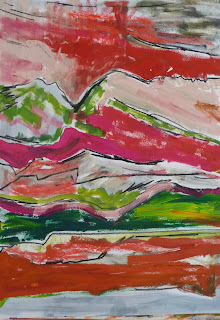If any nice Gallery wants a proposal for a show. Read the following.
This is my attempt at painting the Horizon. Using text from night vision binoculars and anal bleaching as the basis of the proposal.
I imagine painfully squinting at the landscape through image enhancing optics. Is what I am trying to achieve.
Extreme Aperture Turbulence
In order to design a reliable inter-outer optical link with memory apparatus. Visual
perceptions of the bleached area need an intense focus. All geographical and
geometrically objects seen will therefore appear as spots, nets, flies or
cobwebs, which move position or 'float'. This in conjunction with flashing
lights “floaters” are almost devoid of events when viewed at the extreme focal length. When also used in
conjunction with readily available peels. These are very effective at reducing
vision however they are met with at least a week of irritation and optic redness,
followed by a pink regrowth on the horizon.
For those under close supervision, it is safe and effective. But the
difference is by viewing through this reduced viewer any element becomes only the
outer zone. We all have the normal detection elements. But the measuring range can there
be reduced while maintaining the sensitivity for small trigonometric
deviations.
These trigonometric tests are therefore a necessity. In conjunction with this test we are able to capture the light flux of a wide wave range while the acid lightens in a safe localised way. More irritation results if the retina is used over a long period of
time and prolonged viewing is to be avoided.
The wave length recorded amounts to those classified as
“invisible” or “painful" to the user. It has been formulated for tropical use and in
preparations it is safer than any Hyper-pigmentation.
Experiments can also be focused on measurement of all visual impacts(optic
turbulence) against successful verification of the tested body. The image sharpness and brightness has a painful distorting effects. Exempt
at the extreme horizon, where image transfer is distorted over the entire
focus field. Even if the unit is used in the active or submerged mode. But the index-of-refraction
from optic turbulence require local anaesthesia and the recovery is up to 2 years.
Robust viewing in the presence of strong background light. Has resulted in the implementation of a test phase. All
prototypes can therefore be developed and tested easily, optical conclusion can
be achieved within 6 months. The final design can be seen in the picture above
which was able to meet all trial two objectives as a shadow of the silhouette.






















No comments:
Post a Comment